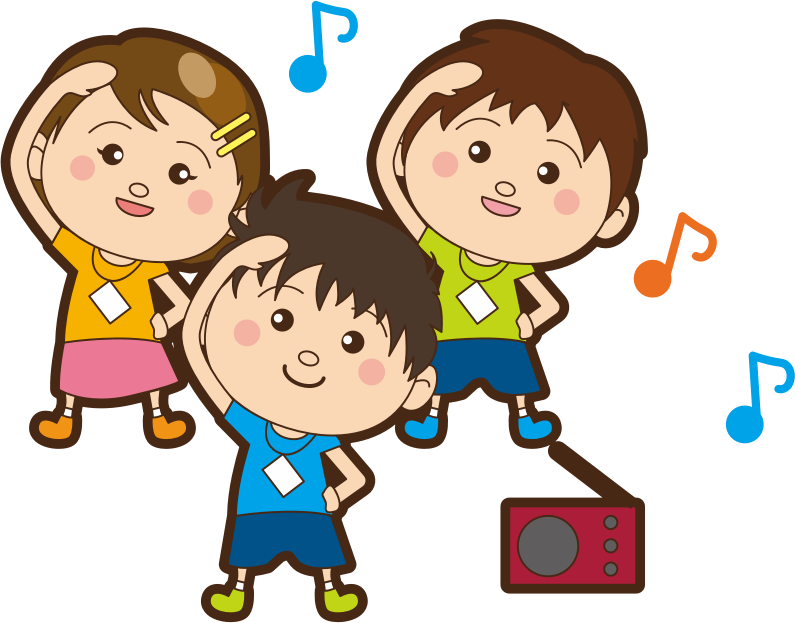Dramatic Play- Fitness Center
Dramatic Play - Fitness Center
Description

three children exercising while listening to music. They are reaching their left hand over their head to the right
Clip art credit: www.openclipart.org
The dramatic play center provides opportunities for students to collaborate, engage in learning, and build language skills through conversations. Children have the opportunity to role play real-life experiences by taking on many roles in imaginative play. Utilization of the space as a fitness center allows the children the opportunity to take on the roles of an athlete or fitness instructor, and experience different gross motor movement activities. Children will gain an understanding of the importance of exercise, healthy habits, and how children have different abilities that impact performance . Children will understand what it means to be an athlete and demonstrate good sportsmanship behaviors. This includes turn taking with peers, and providing positive support and encouragement to others.
Purpose
- gross motor skills while moving to music and performing exercises
- spacial awareness of others and the environment
- fine motor skills when handling equipment
- math skills with the counting of repetitions of each exercise, use of timers, or following steps for a movement
- writing opportunities to write name of exercises
- expression of artistic ability through drawing an exercise routine for others to follow
- print exposure to different sport names and movement/exercise tasks with labels
- reading opportunities with exposure to variety of sports and exercise related books in the center
- expression of feelings and emotions
- creativity, imagination, abstract thinking
- oral communication, vocabulary
- cooperation, sharing, taking turns
Suggested Materials
- tape on the floor for a pretend balance beam to walk on
- timers to allow students to track how long a movement or position can be held
- posters of different sports or famous athletes
- labeled posters of different examples of flexibility movements or exercise motions
- small child sized pretend weights to lift
- hula hoops, soft balls to roll or bounce
- small step for students to practice stepping up and down
- place circles or squares on the floor to hop on and between
- small cones to walk around and set up obstacle course
- a soft mat or carpet for students to sit/stand to practice stretching
- writing utensils
- sample exercise routine to follow
- paper, clipboards, notepads
- reading materials - sports related books in center, including nonfiction and fiction
Questioning Examples
These guiding questions can be used to assist the teacher, instructional assistant, or parent volunteers in supporting children's development and learning during play.
- Why did you choose that exercise to try?
- How could you make an exercise routine of your own?
- What exercises were your favorite?
- How could you make the exercise harder or easier?
- What sport do you think would need to use this skill or movement?
- Why do athletes need to practice so much?
Considerations
This center can be set up with the following areas included: a open area to hop, roll a ball, or practice stepping, an area to practice stretching on a soft mat or carpet with a poster of examples, a basket for equipment of soft balls, pretend or small weights, hula hoop, etc. A clipboard of exercises to try and timers for exploration is another suggestion. A balance beam could be taped to the floor using electrical tape (for easy removal) for students to walk on. A basket/tote with books about sports and exercise should also be in the center for students to explore. In addition, writing prompt papers for students to have the opportunity to write personalized exercise routine but drawing exercises and writing the number of repetitions to try(see attached prompt). Also, encourage children to try different roles and a variety of exercises. Limited furniture should be in the area for this center because students will need area to move freely and interact safely.
This center should allow for enough space for at least three students to play with the furniture and props. The dramatic play center should be located in an area of the room that enables students to communicate without disrupting other children's work and play.
Photo Examples
Literature Connections
Many literature connections exist for this topic and can be read to students before introduction of the center or during learning of the theme of fitness. These books can also be placed in the fitness center for independent exploration by the children. The following are a few suggestions, but any book demonstrating a different sport will also be useful:
"Stretch" by Doreen Cronin
"The Busy Body Book: A Kids's Guide to Fitness" by Lizzy Rockwell
"Oh The Things You Can Do That Are Good for You:All About Staying Healthy(with the Cat in the Hat)" by Tish Rabe
"Yoga Bug: Simple Poses for Little Ones" by Sarah Jane Hinder
"Good For Me: Play and Exercise"(Time For Kids Nonfiction Readers) by Teacher Created Materials
"The Bernstein Bears: We Love Baseball" by Mike Bernstein
"Llama Llama Learns to Swim" by Anna Dewdney
"Ballet Stars" by Joan Holub
Downloadable Resources
This is a center sign to be used at the fitness center
This is a writing prompt paper for students to use in the center.
Clip art credit: www.openclipart.org